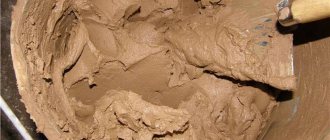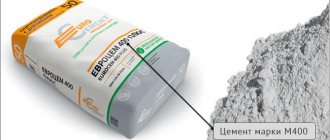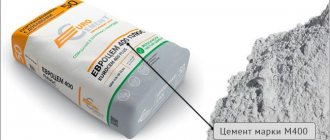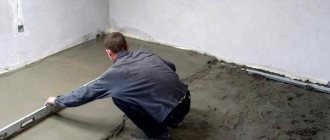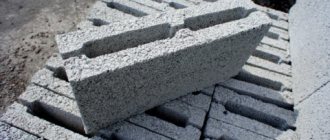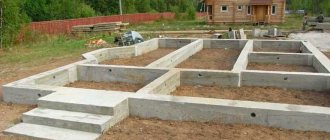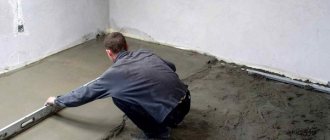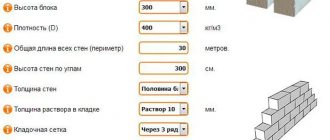Classification of solutions
Basically, masonry mortars are divided according to the type of binder. To do this, either lime or cement is added to the mixture. But in this case there are four types of solutions:
- Lime.
- Cement.
- Lime-cement.
- Clay.
Let’s give several characteristics to each type, indicating their pros and cons accordingly:
- Cement mortar is the most commonly used in brickwork. It has increased strength and low moisture permeability. Today it is used in the construction of buildings and structures of various heights and complexity. It is cement mortar that is used in the construction of brick or block foundations.
- Lime. It has high plasticity and good thermal insulation properties. It has low shrinkage and low specific gravity. It is very convenient to work with such a solution. But it is recommended to use it in low-rise construction, because the mixture will not withstand heavy loads.
Lime mortar for masonrySource kamtehnopark.ru
- Cement-lime. This solution has all the characteristics of the two previous varieties. There are no restrictions on use in construction.
- Clay. It is rarely used in construction today, although it has a number of worthy advantages. For example, high plasticity and frost resistance. The only thing that discourages builders from using it is the complexity of the batch associated with the preparatory work. To do this, the clay must be sifted and cleared of debris, plus crushed to the required state.
We will discuss below how to prepare mortar for bricklaying with different binders. Now let's continue to look at the classification.
The next point of division is the complexity of preparation. There are two types:
- Simple. Essentially, it is a mixture of one binder and sand. That is, it can be a cement-sand or lime-sand mixture.
- Complex ones, where two binding components are involved at once. That is, it is a cement-lime mortar.
Another position is on functional and technological properties. There are three types:
- fatty solutions;
- normal;
- skinny.
Preparation of masonry mortarSource promtech33.ru
They differ from each other only in the amount of binder added. The more of the latter, the “fatter” the solution. It is this material that has increased strength, but at the same time it has the highest shrinkage, which leads to cracking of the applied mass after hardening. It is clear that the skinny version has low strength and ductility. It belongs to budget options. It is better not to use both the first and second in private housing construction. Therefore, it is recommended to mix normal solutions.
And the last position of the classification is by specific gravity. There are two types:
- heavy – weighing more than 1500 kg/m³;
- light – up to 1500 kg/m³.
Clay mortar for bricklaying Source 2proraba.com
A little about the factors affecting consumption
Mortar is the connecting link between bricks. Without it, it is impossible to build a wall. It must be of high quality, properly prepared and have the appropriate consistency. One of the important points that must be taken into account when calculating is its type of composition. The most common are 4 types of solution:
- Cement-sand mixture. It consists of cement, sand and water. This composition can be called the most durable if you strictly adhere to the application technology. Otherwise, there is a danger that it will crack.
- Limestone mixture. There is no cement in its composition; it is replaced by quicklime. The mixture is quite flexible and easy to work with. But there is one drawback - rain will easily wash it out. That is why it is used only for interior work.
- Mixed solution. The composition of this mixture is combined, and combines materials from the first two types. The result is a high-quality solution that is superior to the first two.
- Composition with plasticizer. Sand of 2 mm fraction and cement are additionally mixed with a polymer additive, which increases its plasticity.
These are the most popular mixtures used in construction. But, you should know that they are not the only ones that affect consumption. An important factor is the brick itself. Its size, format, ability to absorb water and the presence of voids directly determine how much mortar will be in 1 m2 of brickwork. In general, the consumption per 1 m 3 of brick is 0.2–0.25 m 3. It all comes down to the fact that the thickness of the wall plays a role, be it half a brick, one, one and a half or two. The greater the thickness, the greater the consumption. The same goes for the shape of the brick. For example, if it is large, then the flow rate is reduced, if it has holes, then the flow rate increases significantly. How is the mortar for bricklaying calculated?
How to use the table?
Since when preparing concrete and masonry mortars it is generally accepted to operate with the volumetric characteristic “1 m3”, we calculate (reduce to 1 m3) the amount of cement for the preparation of 1 m3 of mortar with the “cement-sand” ratios of 1:3 and 1:4.
When making practical calculations of the amount of cement, novice developers make a serious mistake. They believe that if it is necessary to prepare a solution from 1 part cement and 3 parts sand, then the weight of 1 m3 should be divided by 4 and thus obtain the number of components. Actually this is not true. Since cement particles are much smaller than sand grains, it fills the voids between the sand grains, so more cement is needed. To carry out any calculation of the components of cement and sand, we will accept the following assumptions:
- One “cube” – 1000 liters;
- The volume of a bag of cement weighing 50 kg is 36 liters;
- The weight of one “liter” of cement is 50/36 = 1.4 kilograms;
Option for cement:sand ratio 1:3
To prepare the solution you will need 1 m3 of sand and 1.3 m3 of cement, which corresponds to 333 liters of cement. 333x1.4=466 kilograms of cement will be required to mix 1 m3 of masonry mortar.
Option for cement:sand ratio: 1:4
To prepare the solution, 1 m3 of sand and 1.4 m3 of cement are required, which corresponds to 250 liters of cement. 250x1.4 = 350 kg of binder will be required to mix 1 m3 of masonry mortar.
Using the obtained calculation data and the table data, as an example, we calculate the amount of cement required to mix the amount of masonry mortar per cubic meter of brickwork from a single brick of a normal format with a thickness of “1.5 bricks”.
For 1 m3 of the specified masonry, you will need to spend 0.234 m3 of solution (table). Therefore, the amount of cement solution with a ratio of 1:3 is 466x0.234=109 kg; for a ratio of 1:4 – 350x0.234=82 kg.
Using the given technology and tabular data, you can calculate the required amount of cement for masonry mortars of any ratio of components - just substitute your data.
You can also use the calculator to calculate the required amount of bricks for your home, garage or outbuilding.
Calculation of how much mixture is needed per 1 m3
Intuitively, every person should understand that the consumption of the presented mixture will depend on the strength of the structure that will be erected. For example, to build a foundation you need M300 concrete and no lower, but for a screed, a solution with a strength of 150 kg/cm2 is quite suitable. Each brand of mixture has its own properties and scope of application.
The higher it is, the less material is needed. Knowing the consumption of the mixture per meter cubed is very important, because in this way you can purchase the exact amount of material and not worry that you will need to bribe it. In addition, when purchasing, you can even purchase material in a larger volume, since its consumption is greatly influenced by the type of structure being built. It will also be interesting to read about how many bricks are in 1 m3 of masonry.
Plastering walls
When performing such work, a classic plaster mortar is most often used. It contains components such as sand, cement, taken in a ratio of 1:3.
When leveling the surface, material consumption will be directly related to the thickness of the applied layer. If this parameter does not exceed 12 mm, then for 1 m3 of plaster you will need to stock up on 1.6 kg of M40 mixture or 1.4 kg of M500 mixture. The volume of solution per m2 is easy to calculate. To do this, we use the above formula: 1m2x0.012 m = 0.012 m2 or 12 liters.
Here you can see photos of the base panels.
Types of mortars for brickwork
For bricklaying, different types of mixtures are used. Cement is most often used as a binder; various components and additives are added to it. Before calculating the volume of building materials, the type of mortar is determined.
The main types of mixtures for brickwork:
- Ordinary (so-called “cold”) mortar - prepared from sand and cement, water. This is a classic recipe for a mixture that, after hardening, provides good strength and sufficient load-bearing capacity of the wall. The proportions of the components can be different - much depends on the brand of cement used and the brand of concrete that needs to be obtained. Most often, cement M400/M500 is taken and prepared in a ratio of 1 to 4.
- A mixture of Portland cement and lime - in this case it is possible to save on cement, but not on the quality of the masonry, which turns out to be moisture-resistant and quite durable. Often dry components are additionally introduced into the solution to increase viscosity and water/frost resistance.
- Lime mortar - quicklime here acts as a hardener and is used instead of cement. The main advantage of the solution is the plasticity of the composition, which lasts quite a long time. The main disadvantage is that lime strongly absorbs moisture, so many insulation materials cannot be used with it, and over time this property can cause the composition to be washed out of the masonry under the influence of precipitation and external negative factors.
- Mortar with plasticizer - special polymer additives are added to sand and cement to increase the plasticity of the mixture. This solution is usually mixed dry, and then water is added according to the instructions.
Regardless of what composition was chosen and what the consumption is, the requirements for all mixtures are practically unchanged. All components must be thoroughly cleaned of impurities, dirt and lumps, and the liquid lime must be filtered.
If the choice was made on a cement-lime mortar, it is also worth considering some nuances: the mixture is good for use for about 5 hours, but in the summer at a temperature of +25 degrees it is better to use it faster (in some cases, the solution may become unusable after just an hour). For 1 cubic meter of mixture take 190 kilograms of M400/M500 cement, 1.5 m3 of sand, 160 kilograms of hydrated lime and about 470 liters of water. Thus, about 46 kilograms of cement are used per cubic meter of masonry.
Types of bricks for construction
First of all, bricks are divided into two large groups depending on the material of manufacture:
- ceramic;
- silicate.
Red ceramic brick is based on high-quality clay with a minimal amount of impurities. After molding, it is fired in ovens at temperatures from 1000 to 1300 degrees.
Sand-lime brick consists of quartz sand and lime. After pressing, it is exposed to water vapor at a temperature of 170-200 degrees and a pressure of 8-12 atmospheres. Also, various impurities are often added to it, for example, titanium dioxide allows you to maintain the snow-white color of the product for decades.
It is also important for us to know what they can be depending on the content:
- full-bodied;
- hollow.
From the name it becomes obvious that solid brick does not have cavities. It is the most durable and is used for the construction of load-bearing walls. The void ratio is extremely small, for ceramic brick it is 5%, for silicate brick – 12%.
Hollow bricks contain two or more holes inside, which are used to retain heat and increase sound insulation. The void ratio can reach 40%. They are used to create partition walls or as cladding.
The last characteristic we are interested in is the size of the brick. According to GOST 530-2012, ceramic bricks are divided into nine different standard sizes (SF), and silicate bricks according to GOST 379-2015 are divided into five. Only three of them are particularly popular in Russia:
- single (1 NF) 250x120x65 mm;
- one and a half (1.4 NF) 250x120x88 mm;
- double (2.1 NF) 250x120x140 mm.
Two more types of blocks are also widely used:
- euro (0.7 NF) 250x85x65 mm;
- modular (1.3 NF) 288x138x65 mm.
What size blocks to use during construction is up to everyone to decide for themselves. There are no structural differences; the house will be equally strong if it consists of both double and single bricks. The aesthetic component is fundamental most people prefer the classic single brick.
The only objective point that is really worth paying attention to is the construction time and the price of materials. As a rule, one-and-a-half and double bricks are cheaper, and the amount of cement mortar required for installation is also reduced. And due to the larger size of the blocks, less time is required to construct the structure.
Cement consumption
After calculating the required amount of the mixture, it remains to find out how much and what brand of cement should be purchased. At the same time, it is always better to buy cement “with a reserve” - in case of unexpected consumption or a large error in the calculations.
If a total of 20.0 m3 of mixture is required, and the proportion of the solution is 1:3, then the resulting value must be divided by 4. The result is 5.0 m3 of cement. However, cement is not measured in cubic meters; you will have to convert it to kilograms. To do this, you need to know the density of the hardener, which can vary greatly between brands. The average value is approximately 1300 kg/m3. Taking into account the knowledge of this indicator, it remains to make simple calculations: multiply the density by the volume. Thus, you get 5.0 * 1300 = 6500 kg, or about 130 bags, taking into account that the weight of each bag is 50 kg.
Determination of cement content
It should be remembered that the masonry mortar begins to harden quite quickly, so it is not worth preparing it for future use.
The easiest way to perform the necessary calculations is to take 1 m3 of masonry as a basis, consisting of 400 bricks. On average, its installation requires 0.25-0.3 cubic meters of solution. Knowing this, you can make simple approximate calculations and determine the required consumption of binder per 1 m2; walls of any thickness.
Calculations are performed in the following sequence:
- calculate the area of the wall by multiplying its length by its width;
- determine the expected volume of masonry work by multiplying the area of the wall by its thickness. It should be noted that the construction of load-bearing structures is usually carried out in 1.5 or 2 bricks. Their thickness will be 38 or 51 cm, respectively. Internal partitions are made of 1 or 0.5 bricks, which will be 25 or 12.5 cm. For example, we give a calculation for the construction of a wall laid out with 1.5 bricks, the area of which is 12 m2: 0.38 x 12 = 4.56 m3;
- the estimated amount of mixture for a given amount of work. 4.56 x 0.25 = 1.14 m3; It should be borne in mind that the estimated need may change both up and down depending on the material used and the experience of the craftsman. Therefore, the calculated amount is quite approximate.
- Knowing the required ratio of components, we determine the required need for cement: 1.14. 5 = 0.23 m3;
- since the weight of 1 m3 of cement is 1300 kg, then in this case you will need: 0.23 x 1300 = 296 kg.
The weight of one bag of cement is about 50 kg. This means that to build the wall taken as an example, you need to use 5 bags. Similarly, you can determine the approximate consumption of binder for any brick structure.
Advantages and disadvantages of laying brick walls
According to some experts, the popularity of brickwork remains more due to tradition than quality. However, after the first experience of operating residential buildings made of insulation, many developers prefer to use time-tested building materials: brick, wood, cinder block. Their main advantages (ecological cleanliness, good sound insulation, strength) allow them to withstand competition in the modern building materials market quite well. Brick walls are able to bear the weight of reinforced concrete floors, which makes it possible to erect buildings of several floors. The durability of brickwork has been tested for more than one century. The ideally calculated size of the brick allows you to perform brickwork with the installation or installation of various decorative elements, to make walls of complex configurations, columns, arches.
To accurately calculate the weight of cement, you need to take into account the degree of leveling of each layer, the width of the seams, as well as other important nuances.
Negative properties of brick walls:
- Products can absorb moisture in large quantities. In conditions of high humidity, dampness in the premises and mold may occur.
- The specific gravity of the material, which increases the cost of its transportation.
- The foundation is under significant load due to the heavy weight of the brickwork. After the construction of the walls is completed, shrinkage of the building may occur.
- Wall installation work cannot be automated. Brick laying can only be done by hand. Without some experience, it is impossible to lay brick on an industrial scale.
The disadvantage of this material is its cost, so developers quite often use a combined wall design. The main supporting structure is made of wood; a layer of insulation is mounted on the outside. After the wooden walls undergo shrinkage processes, they are faced with finishing bricks.
Information on the purpose of the calculator
The online brick calculator is designed to calculate the amount of building and facing bricks for a house and basement, as well as related parameters and materials, such as the amount of masonry mortar, masonry mesh and flexible connections. Also, the calculations can take into account the dimensions of gables, window and door openings of the required number and size.
When filling out the data, pay attention to the additional information with the Additional information sign
Since ancient times, brick has been the most popular, widespread and familiar building material for the construction of long-term and reliable structures. This situation persists for a number of reasons, despite the emergence of new, modern and cheaper building materials. There are several most common types of bricks for any construction needs:
- Adobe - made of clay and various fillers
- Ceramic - (most common) made from baked clay
- Silicate - made of sand and lime
- Hyper-pressed - from lime and cement
- Clinker - made from special baked clay
- Fireproof - (fireclay) made from fireclay
Ceramic brick
(clay) are divided according to purpose into façade, ordinary and clinker. Ordinary brick (backfill) may not have an ideal geometry and in most cases is used for laying rough walls of houses, plinths, garages, which are subsequently plastered, painted and protected with facing materials and coatings. Its color has various shades of red.
About facing
(facade) are used for the construction of walls without any additional finishing in the future. There are also various special types of facade bricks that can withstand high mechanical loads and adverse atmospheric influences, and are usually used for paving paths, building all kinds of retaining fences, stairs, and walls.
K linker
It has an ideal smooth surface, various shades of red and black colors and is highly dense.
With silicate
is a light-colored lime-silicon artificial stone. Sand-lime brick differs from ceramic brick in that it is not fired during the manufacturing process. It is quite hygroscopic, and accordingly is not used for the construction of objects that will be operated in humid environments, such as the basement and basements.
Also, sand-lime brick is not used in the construction of furnaces, pipes, chimneys and foundations, since it withstands external destructive loads quite poorly.
Oh fireproof
is divided into several types and is used for the construction of structures exposed to high temperatures, such as stoves, fireplaces, chimneys and smelters. The most common is fireclay brick, it has a yellowish tint, made from special fireclay (chamotte) and, unlike ordinary clay brick, can easily withstand high temperatures (up to 1400 degrees), as well as numerous heating and cooling cycles without loss of strength.
Irpichy can be solid (volume of voids no more than 25%), hollow and porous-hollow. It is believed that depressions and voids in the material not only reduce weight, but also significantly increase the overall strength of the masonry by increasing the contact area between the brick and the mortar.
The most common standard brick size: 250 - 120 - 65 mm (length - width - height), the so-called first “normal form” (1NF).
When calculating the amount of brick required for work, they usually use a rule called “format”, in which the dimensions of the brick itself are increased by 10 mm (this is the standard joint thickness), that is, it turns out: 260x130x75 mm.
Below is a complete list of calculations performed with a brief description of each item. If you haven't found the answer to your question, you can contact us via feedback.
Requirements for masonry mixture
The requirements for masonry mortars are described in detail in GOST 28013-98. According to this document, the following requirements apply to mortar mixtures:
- the composition must have a high degree of adhesion to brick and other substrates;
- withstand large amounts of freezing and defrosting;
- to ensure that the masonry does not collapse under the influence of atmospheric influences and temperature changes, the masonry mixtures must have high water resistance;
- due to the plasticity of the mortar, during the laying process, it becomes possible to timely adjust the position of the masonry material, which significantly increases the quality and productivity of the work;
- water-retaining properties prevent decomposition of the mixture and precipitation of heavy fractions;
- the strength characteristics of the composition are decisive in the calculation of building structures. This parameter shows what maximum loads the material can withstand. The brand of the solution reflects its strength in kgf/cm2.
Failure to comply with these requirements leads to the formation of cracks in the brickwork, increased consumption of the mortar mixture, increased thickness of the joints and reduces work productivity.
Mortar for brickwork
Mortar for joining masonry is needed in any case. The most popular compositions are:
- Cement-sand mortar. This is a classic, cement is mixed with pre-sifted sand, usually in a ratio of 1:3 or 1:4, although there are other options depending on the brand of cement. The mixture is diluted with water;
- Lime. Quicklime is used instead of cement. This composition is never used for external masonry, only indoors, as it is easily washed out with water;
- Mixed. Liquid slaked lime, which is commonly called milk of lime, is added to cement and sand. The result is a composition that takes the best qualities of the first two options;
- With the addition of a plasticizer. It will increase the plasticity of the mixture. Often such building compositions are sold ready-made, in dry form and simply diluted with water, according to the instructions. Sometimes masons add detergent or washing powder as a plasticizer.
Despite the fact that the composition of the masonry mortar may be different, the requirements for its consistency are the same. The sand must be sifted, the liquid lime is filtered, there should be no lumps, water is added gradually. The mixing process will significantly speed up the use of a concrete mixer.
The following factors influence the amount of solution consumption:
- Wall thickness;
- Brick quality;
- Type of brick - hollow brick will require more mortar for obvious reasons;
- Masonry skill;
- Weather conditions, in particular humidity and temperature.
How difficult, you say. However, experts have long derived average, but fairly accurate indicators of mortar consumption per 1 m3 of brickwork. The standard brick dimensions are well known - 250x120x65 mm. The expense will be:
There are approximately 404–405 bricks in 1 m3 of masonry. That is, for one ordinary, single brick there is about 0.00063 m3 of mortar. Convert to liters - 0.63. When laying one brick, there are approximately 100 blocks per square meter of wall. Experts insist that the solution must be prepared with a small reserve and indicate the ideal proportion - 75 liters of the mixture should be used per square meter of wall. For a wall of one and a half bricks, the consumption will be already 115 liters.
Important! There is SNiP II-22–81, which sets requirements for the quality of brickwork. The optimal thickness of the seam, that is, the thickness of the mortar used, should be 10–12 mm
All this is great, thanks to the specialists with solid experience in brick construction, you can say. But cement is sold in 50 kg bags, so additional calculations need to be made.
As you remember from the school curriculum, 1 m3 = 1000 liters. The volume of a 50-kilogram bag of cement will depend on the density of the material. Let's take the standard value of 1300 kg/m3. 1300/1000 = 1.3 kg weighs a liter of cement.
Let's say you make a classic mixture of M400 or M500 cement with sand in a ratio of 1:3. In this case, per cubic meter of sand you will need 333 liters of cement, multiply by 1.3 = 432.9 kg, almost 9 bags.
As we remember from the table, to lay a wall of one and a half silicate bricks you need 0.24 m3 of mortar. 432.9*0.24 = 103.9 kg of cement or a little more than two standard bags per 1 m3 of masonry.
Now let’s calculate how many bags of cement we need to build a one-story house 3.5 m high, 10x15 m in size and with a wall thickness of two single bricks, that is, 51 cm. Let’s remember the math. Volume = (10+10+15+15)*3.5*0.51 = 89.25 m3. Again, we take a single sand-lime brick, which, according to our table, takes 0.24 m3 for a wall thickness of 51 cm. 89.25*0.24 = 21.42 m3 or 21420 l.
This is exactly how much ready-made mortar is required to build a house. Our standard mixture ratio is 1:3. So you will need 21.42/3 = 7.14 m3 or 7140 liters of cement, multiply by 1.3 = 9282 kg. That is 186 50-kilogram bags. Quite a lot. You can save money by using M500 cement in a 1:4 ratio with sand. Then you get 116 bags.
The calculations are not too complicated if you use standard consumption indicators and remember the math. Experts advise taking materials with at least a 5% reserve, because during the construction process unforeseen difficulties may arise and consumption will increase. Published by econet.ru
If you have any questions on this topic, ask them to the experts and readers of our project here.
PS And remember, just by changing your consumption, we are changing the world together! econet
What compounds are used
The most famous and popular mixtures:
- Traditional universal building composition of sand and Portland cement. The standard ratio of components is three to one or four to one;
- A working mixture of sand and quicklime. Applicable only for interior masonry work;
- Mixed composition for brickwork. These are quartz sand, cement and slaked lime;
- Cement mixtures with plasticizer additives.
General standards according to SNiP II-22–81: sand must be washed and sifted, milk of lime must be strained, cement must be fresh and without lumps. All compositions are mixed with clean technical water. Water is added to the dry mixed ingredients in portions until the required consistency is achieved.
Cost of solution per cubic meter of partition
The solution consumption rates per 1 m3 are affected by the following process parameters:
- Base thickness and quality of brick blocks;
- A type of brick - it can be solid or hollow;
- Climatic conditions - air temperature and humidity, sunny or cloudy day.
Practice shows that for a 1m2 building made of ordinary brick, 75 liters must be prepared. A structure of one and a half bricks will require the preparation of 115 liters of working mixture, a base of half a brick will take 40 liters of cement composition per 1 m2.
According to SNiP 82-02-95, which show that the mortar consumption rates per 1 m3 of brickwork are as follows:
- 0.19 cubic meters for half-brick masonry;
- 0.22 cubic meters for laying one brick;
- 0.235 cubic meters for masonry in one and a half blocks;
- 0.24 cubic meters for laying two bricks;
- 0.25 cubic meters for masonry in two and a half blocks.
More accurate and expanded data is contained in SNiP II-22–81.
Wall mortar - how much is needed per 1 m2
How to find out the consumption of mortar per 1 m2 of brickwork? To avoid doing the calculations, there is a table of all the components included.
It takes into account the consumption of mortar for laying bricks from different materials:
| Variety | Compound | Proportions of components for the layer | ||
| Spray | Priming | Covering | ||
| Slaked or quicklime | Lime milk and quartz sand | 1,0:(2,5-4,0) | 1,0:(2,0-3,0) | 1:(1,0-2,0) |
| Portland cement | Portland cement and quartz sand | 1,0:(2,5-4,5) | 1,0:(2,0-3,5) | 1,0:(1,0-1,5) |
| Clay | Quartz sand and clay | 1,0:(3,0-5,5) | 1,0:(3,0-5,5) | 1,0:(3,0-5,5) |
| Lime-cement | Portland cement, lime milk and quartz sand | 1,0:(0,3-0,5): (3,0-5,0) | 1,0: (0,7-1,0): (2,5-4,5) | 1,0:(1,0-1,5):(1,5-2,5) |
| Gypsum-lime | Lime milk, gypsum and quartz sand | 1,0:(0,3-1,0): (2,0-3,5) | 1,0:(0,5-1,5):(1,5-2,5) | 1,0:(1,0-1,5): (1,5-2,5) |
| Clay-lime | Lime milk, clay and quartz sand | 0,2-1,0:(3,0-5,0) | 0,2-1,0:(3,0-5,0) | 0,2-1,0:(3,0-5,0) |
| Clay-cement | Portland cement, clay and quartz sand | 1,0:4,0:12,0 | 1,0:4,0:12,0 | 1,0:4,0:12,0 |
Consumption rates for building mixtures for different types of building blocks
About 0.0108 m3 of composition is consumed per unit, and 0.054 m3 of mixture will be needed to cover 50% of the seam. The arithmetic mean of these two values is 0.08 m3. This value determines the consumption of mortar per 1 m2 of brickwork.
For different masonry this parameter will be equal to:
- When erecting a half-brick partition - 0.04 m3;
- Private - 0.82 m3;
- One and a half - 0.125 m3;
- Double - 0.164 m3.
The table shows the mortar consumption rates for brickwork made from blocks of different sizes for partitions of different thicknesses:
| Type of work | Scope of construction work | Volume |
| Masonry work | 1 m2 with a base thickness of a quarter of a briquette | 14 liters |
| 1 m2 with a base thickness of half a brick | 35 liters | |
| 1 m2 with a thickness of one brick | 75 liters | |
| 1 m2 with a wall thickness of one and a half bricks | 115 liters | |
| Plastering | 1 m2 of mantel without grouting using fine gravel | 13 liters |
| 1 m2 of plaster of internal surfaces | 17 liters |
In this case, the solution consumption per 1 m3 will be equal to:
- When working in half a brick for 53 building units - 0.19 m3;
- For single masonry for 102 blocks - 0.22 m3;
- One and a half for 153 units - 0.23 m3;
- Double for 204 blocks - 0.24 m3.
Thickness of joints in masonry
Another parameter that affects the consumption of masonry mixture. There are standard dimensional parameters for the thickness of the gaps between bricks, which craftsmen must adhere to. It is these dimensions that ensure the strength of the entire structure. Here are their parameters:
- horizontal seams should have a thickness of within 12 mm;
- vertical 10;
- longitudinal in the range of 12-15 mm;
- transverse 8-10.
It is not always possible to adhere to these indicators. Causes:
- low skill of the workman;
- climatic conditions;
- geometric unevenness of bricks.
The last reason is considered the main one. Most often, this is a criterion for excessive consumption of masonry mixture. To lay the stones evenly, you have to increase the mortar in some areas to hide the unevenness of the blocks.
So, everything is clear with the thickness of the seam. The thicker it is, the more solution you will have to use.
Thickness of joints in brickworkSource etokirpichi.ru
Calculation of the amount of building material
When calculating, two methods are often used. In one, calculations are carried out taking into account the mortar joint, and in the second they are not taken into account. Typically its thickness ranges from 5 to 10 mm.
It is important to know! If the second method is used in the calculation, there is a chance of obtaining an excess of building materials, approximately 30%. The first method is more economical, but it also has its pitfalls
10-15% should be added to the resulting amount of material. These percentages take into account possible brick breakage during construction.
Example. For better understanding, let's look at an example. It is necessary to build a one-story brick house with the following dimensions:
- Length – 12 m;
- Width – 10 m;
- Height – 4 m.
The calculation is carried out only taking into account external walls. They have one door (1x2 m) and three window (1.2x1.5 m) openings. Brick type: regular single. Laying method: two bricks. Mortar joint: 7 mm.
So, calculating the amount of building materials for the construction of the specified house using the first method should look like this:
First you need to determine the perimeter of the external walls (1). Then you can calculate their area (2). Next you need to calculate the area of the openings (3). Now you can calculate the area of the masonry itself (4). The next step will be to determine the amount of building material per 1. To do this, you need to calculate the area of the frontal surface of the brick (5) and divide the resulting value by 1 (6), and then multiply by 2, since in our case the laying is carried out in two bricks (7). Total: 256 bricks per 1.
Result: to build the walls of a house according to the above parameters, you will need 31,898 bricks.
To calculate the amount of building material using another method, you need to add the thickness of the seam to the size of the brick, in our case it is 7 mm (9). From this it turns out that the number of bricks per 1 will be 219 pieces (10). Now we multiply this amount by the total area of the masonry (11), additionally adding the amount of material for scrap (1500-2000 pieces) and we get approximately 28,800-29,300 pieces.
Calculations:
- Рн= (12+10)х2=44 m.
- Sc=44x3=132 m^2.
- Sp=(1x2)+(1.2x1.5)x3=7.4.
- Sk=132-7.4=124.6.
- 0.12x0.065=0.0078.
- 1/0,0078=128.
- 128x2=256.
- 124.6x56=31897.6
- (0.12+0.007)x(0.065+0.007)=0.009144.
- 1/0.009144x2=218.723.
- 219xSk=219x124.6=27287.4.
Having analyzed both calculation options using an example, you can see that the first method is more economical.
Calculation using an online calculator
If you don’t want to bother your head with a lot of numbers or you’re simply afraid of making mistakes in your calculations, you can use special online calculators. With their help, you can quickly calculate the required amount of brick. Simply enter the required parameters in the appropriate fields and the calculator will immediately display the result. In addition to calculating the amount of brick, an online calculator can be used to determine other parameters necessary for construction. The main advantage of such calculators is their convenience and accuracy. Using this calculation method, the chance of making a mistake is reduced to zero. Plus they are completely free.
Amount of solution consumption per square meter
Today in construction stores the range of building mixtures is huge, thanks to this you can choose your composition for specific work. When choosing a building material, it is important to know its consumption. In this case, you can purchase the exact amount of the mixture and save on buying unnecessary material. But each type of work has its own expense. DSP is quite convenient and popular material.
For floor screed
How to calculate the consumption of CSP per 1 m2 of screed? The process of calculating the mixture for floor screed is simple, so all these manipulations can be performed in your head. No complex mathematical formulas are used here. Let's look at the whole process using a specific example. For a screed of 10 cm per 1 m2 you will need 50 kg of M400 mixture.
If you need to get highly accurate results, then you need to apply the following formula: multiply the area by the height of the screed. As a result, you should get a number that will indicate the required amount of solution.
For example, the area under the screed is 50 m2, and its height is 8 cm. The above formula takes the following form: 50 m2 × 0.08 m = 4 m3. But grains of cement and sand play a very important role here. When preparing a solution, they reduce their volume under the influence of liquid. Consequently, the total volume of the prepared solution will be less than the amount of materials spent on it. When choosing a material, it is important to consider not only the brand, but also the GOST of the cement for the job.
Consumption per 1 liter is approximately 1.4 kg of dry mixture. To put it another way, from 50 kg of composition you can get 36 liters of solution. As a result, the resulting volume of the mixture will be equal to 2/3 of the volume of materials involved.
This indicator can be calculated only with accurate knowledge of the quality characteristics of the sand used. Often this information is not included on the packaging. For this reason, it is best to calculate the necessary data without taking into account shrinkage, and then add the approximate amount of materials used to eliminate it.
The video shows a recipe for a floor screed solution with a consumption of cement-sand mixture per 1 m2:
Plastering the surface
If you decide to level your walls or simply remove defects such as depressions and cracks, then using sand-cement plaster would be an excellent option. Its consumption will vary with different laying thicknesses. If the layer thickness is 5 mm, then the consumption will be 7 kg per m2.
Here you can watch a video about the disadvantages of a house built on screw piles.
In terms of volume, the amount of solution per 1 m2 with a thickness of 5 mm will be 5-6 liters. The layer thickness can reach from 5 mm to 30 mm. Most often in practice, a bag of cement is used, slaked lime - 40 kg, sand - 550 kg, water - 100 liters. If the process of preparing the plaster was carried out correctly, then it is possible to achieve high-quality wall cladding. In addition, it is quite possible to reduce the consumption of cement for repairs and cladding of the house several times.
General information on the calculation results
- Amount of cement
— The total estimated amount of cement required for the entire solution.
Amount of water
— The total estimated amount of water required for the entire volume
Attention! The final amount of water is selected experimentally, depending on the moisture content of the sand
Number of aggregates
— The total amount of sand (aggregate) for the entire volume in kilograms.
Solution density
— Density of the solution in its wet state.
V/C
— Water-cement ratio.
Proportions
— Relative ratio of solution components. C - part of cement; P - part of the sand; B is part of the water.
Price
— The cost of each material and the total for the entire volume.
Other types of mixtures
When mixing is carried out with the addition of additional substances (clay, limestone, marble, synthesized additives), for 1 part of cement it is necessary to take from 5 to 9 parts of sand. Concrete is made by spending a maximum of 5 quintals of binder to obtain 1 cubic meter. m. ready mixture. The relevant standards are prescribed by the state standard, however, builders can deviate from the regulatory requirements if they need to achieve a certain level of viscosity, make the solution more liquid, or speed up or delay hardening. When working, use buckets and troughs (these are the most suitable containers), a hammer drill with mixing attachments, and shovels for distributing portions.
The mixing is carried out initially on the basis of dry masses. Then water is added systematically and slowly. It is imperative to ensure that the masonry mortar becomes outwardly homogeneous throughout its entire thickness and does not spread too actively. The strength of the concrete and the service life of the brick walls depend on the quality of the mixture.
Sand-cement mortar is characterized by high strength. However, if you deviate a little from the standard technology, cracks may appear. In a mixed version, slaked lime (otherwise called milk of lime) is added to cement and sand.
There is also a type with plasticizing additives, when in addition to cement and a 0.2 cm sand fraction, polymers are used to make the solution more flexible. There is no need to worry about preparing such solutions: it is better to buy ready-made dry kits and dilute them with water as instructed.
Calculator for calculating bricks for masonry - instructions
Brick is one of the most common building block materials used to build a house. Universal recognition is due largely to the fact that brickwork can withstand very heavy loads and is suitable for the construction of multi-story buildings, high-quality material has extremely high durability and does not collapse for 100 years, in addition, facades made of facing ceramics are aesthetically attractive and do not require subsequent finishing .
Our online calculator is capable of calculating bricks for laying the walls of a house with minimal errors, which allows you to reduce the time for preparatory work, draw up an estimate with the consumption of materials, estimate the budget and determine the carrying capacity of transport during delivery.
Brick parameters
- Type of brick . Select the type of block - ceramic (red), silicate (white).
- Execution . Choose a brick design - hollow, solid.
- Size . Select the block size - single 250x120x65, one-and-a-half (thickened) 250x120x88, double 250x120x140, euro 250x85x65, modular 288x138x65.
- Density _ Confirm the block density or enter a different value (from 1000 to 2000 kg/m 3 ).
- Price . Enter the cost of one brick (if necessary, calculate it yourself if the price is per cube).
- Stock . Indicate the stock of material for trimmings, waste and other waste. It is recommended to indicate 3-5%.
Wall parameters
- Wall length . Enter the total length of the outer perimeter walls.
- Wall height . Enter the estimated height of the walls at the corners.
- Masonry option . Select the thickness of the masonry - 0.5, 1, 1.5, 2 blocks.
- Solution . Specify the thickness of the masonry mortar – 10, 15, 20 mm.
- Masonry mesh . Indicate the need to use masonry mesh (optional).
Additional designs
The brickwork calculator allows you to exclude from the calculation bricks in place of which it is planned to place certain structures - windows, doors, garage doors. Parameters for each additional element are specified individually. You can specify multiple objects of the same dimension.
- Window . Enter the height and width of the window, quantity.
- Doors . Enter the height and width of the door, quantity.
- Jumpers . Specify the thickness (height) of the lintel, length, and quantity.
- Armopoyas . Enter the thickness (height) of the reinforcing belt, quantity.
